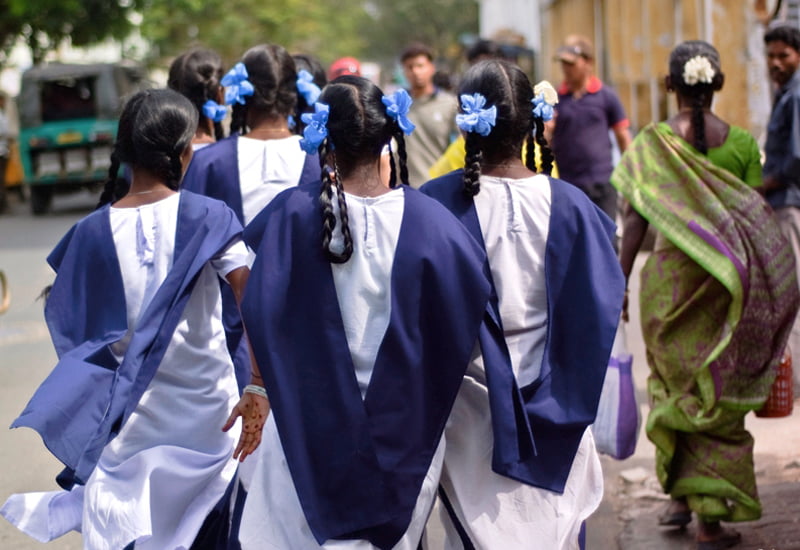From achieving top ranks to sneaking a moment to text your crush on your mobile phone during school hours, teenagers experience plenty of events during their school years. In Amazon MiniTV’s nostalgic series, Amber Girls School, we follow the journey of Ojaswini, as she aims to become the head girl of her school while grappling with hormonal changes.
Amber Girls School is an original story written by Garima Pura Patiyaalvi, co-writer of the Oscar winning documentary The Elephant Whisperers (2022)and Little Things (2016).
Amber Girls School is an original story written by Garima Pura Patiyaalvi, co-writer of the Oscar winning documentary The Elephant Whisperers (2022) and Little Things (2016). ‘I always had a problem with why there’s no woman character that I can relate to in Indian media. So, I did my bit,’ said Patiyaalvi.
Amber Girls School: shifting the spotlight
Set in Chandigarh in 2008, the heart of the story of Amber Girls School lies in sisterhood, where women shape the experiences in each other’s lives. The story revolves around how being a bold girl can be problematic for Tejas (Ojas’s sister), or being a sensitive and emotional one can be problematic for Ojaswini. Amber Girls School also features an under-confident teacher in a mother. ‘Mothers are shown in a confident context in Indian media. However, that’s not the kind of agency they enjoy in real life,’ said Patiyaalvi. The series delves into pressure on women to stand up to societal expectations.
With less space given to male characters, the female perspective of all the characters in Amber Girls School is prevalent. The all-women writers room of the series revealed that the less space given to and the gaze used for Shaurya (Ojas’s crush) and the unemployed father was intentional. ‘Though it was an active decision, it happened organically. It is a women’s story,’ said Pranjali Dubey, the co-writer of the series.
Not a cliche parent-child relationship
Amber Girls School didn’t stick to the cliche “Daddy’s little princess” representation of the father-daughter relationship. But why do filmmakers rarely explore the complexity of father-daughter relationships? Patiyaalvi believes that the prominent creators have mostly been men in the industry, who are afraid to portray such dysfunctional relationships. ‘Instead, we wanted to explore the friendship of the daughters with their mother,’ said Patiyaalvi.
Ojas’s mother portrays herself as a cool mom who gets her daughter ready and drop her to the park for a date. Yet, like any mother, her insecurities kick in as she vigilantly watches over her daughter from behind the tree. ‘We were just revisiting the women around us,’ said Dubey. Usually, the filmmakers are so taken in by the protagonist, that they take supporting roles for granted. ‘Each character is a representation of what a woman goes through,’ said Patiyaalvi.
Silent, ambiguous friendships in Amber Girls School
Amid Ojas’s journey, one can anticipate the emergence of the most ambiguous friendships. Whether seeking solace with a companion sharing the same bus stop or struggling with authority in a healthy competition for the position of head girl at school, women sought support in each other in Amber Girls School. Patyaalvi said, ‘Women are still operating in whisper networks.’
The relationship between Ojas and her sister, Tejas, diverges from what is typically portrayed in mainstream media. Tejas, cognisant of her family’s financial struggles, diligently seeks part-time work to pursue her dreams. Their bond as siblings is organic; while they deeply care for each other and support one another, they rarely verbalise their affection openly. The brazen physical differences between the sisters is another highlight of Amber Girls School.
As Ojas juggles between personal relationships and academics, her friends face their own unique challenges. Srishti, though occupying minimal screen space, stoically absorbs comments flung to her quite carelessly about her body and appearance. ‘Viewers can watch out for women responding to authority in season two,’ said the writer.
Patiyaalvi who has been to an all girls’ school herself, witnessed moral policing around her. ‘Policing on all aspects of who you are, overtly or covertly. From your personality to the bra you’re wearing, everything is under a scanner,’ she said.
As Ojas juggles between personal relationships and academics, her friends face their own unique challenges.
‘Unpopular opinion, but attending an all-girls school provides women with the opportunity to explore their queer identities,’ said Patyaalvi. In the series, Ojas finds herself in competition with Anna, whom she initially perceives as being out of her league. Ojas later discovers that Anna feels the same way. As the “perfect” young women set out on a journey to find romance in life, Ojas feels embarrassed by an unexpected kiss. ‘Their friendship will be further explored in season two,’ the writers revealed.
Debating the relevance of single-sex schools
A research by Mustafa Ozdere, an academician, questioned the benefits of single-sex schools, suggesting that the transition from single-sex schools to mixed-sex environments can pose challenges for students. This lack of exposure to mixed-sex environments during schooling may affect students’ ability to navigate relationships with individuals of the opposite sex in social or professional settings.
To not know how to be around the opposite gender is prevalent in Ojas’s character. Whenever she comes face to face with Shaurya, Ojas doesn’t know how to behave or what to say. ‘Such environments lead to viewing the opposite gender as exotic or unfamiliar,’ said Patiyaalvi. In the series, boys think of girls to be a pretty, cultured and dressed up prize. The skewed perception works for girls who think that their happiness lies in impressing the boys.
Schools are supposed to prepare you for the cruel, real world. ‘Single-sex schools are antithesis of this notion,’ Patiyaalvi said. At an age where youngsters navigate life and career choices, Patiyaalvi found herself becoming accustomed to being around men. ‘It is not even protecting women. It is repealing a part of natural life,’ she said.
At an age where youngsters navigate life and career choices, Patiyaalvi found herself becoming accustomed to being around men.
Dubey, while questioning the existence of such schools, said, ‘Isolating people from each other is never an answer.’ The segregation mentality leads to the birth of other taboos that stem from sex and gender prejudices. ‘But segregation on what basis? In today’s time, we are questioning gender as a social construct.’ At a tender age, where students can learn gender sensitivity, single-sex schools restrict gender to just binaries.








